Uncover the intricate craftsmanship and deep symbolism of ancient Egyptian furniture, ranging from simple wooden stools to opulent gilded thrones. Discover how these exquisite creations embodied social status, spiritual beliefs, and the cultural values of ancient Egypt.
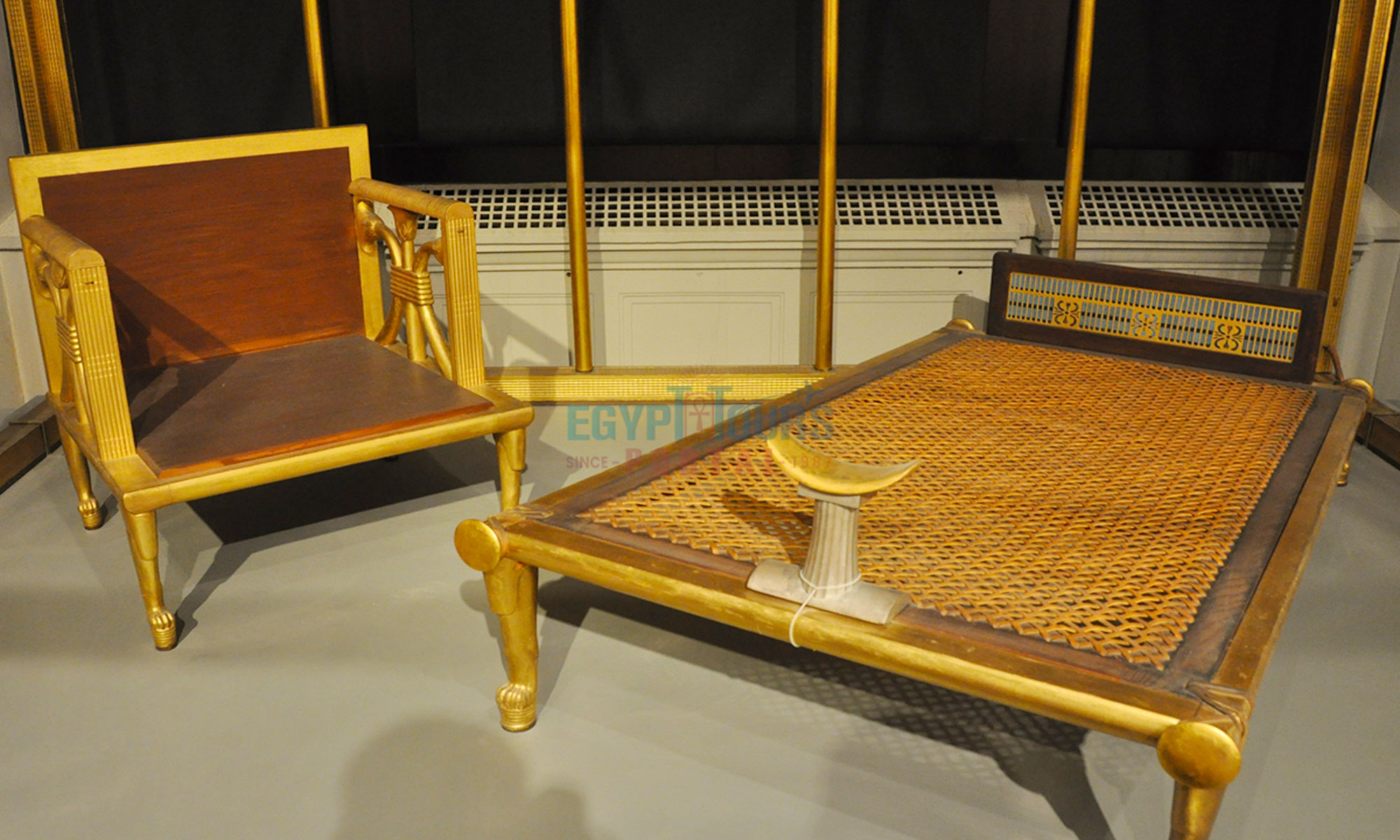
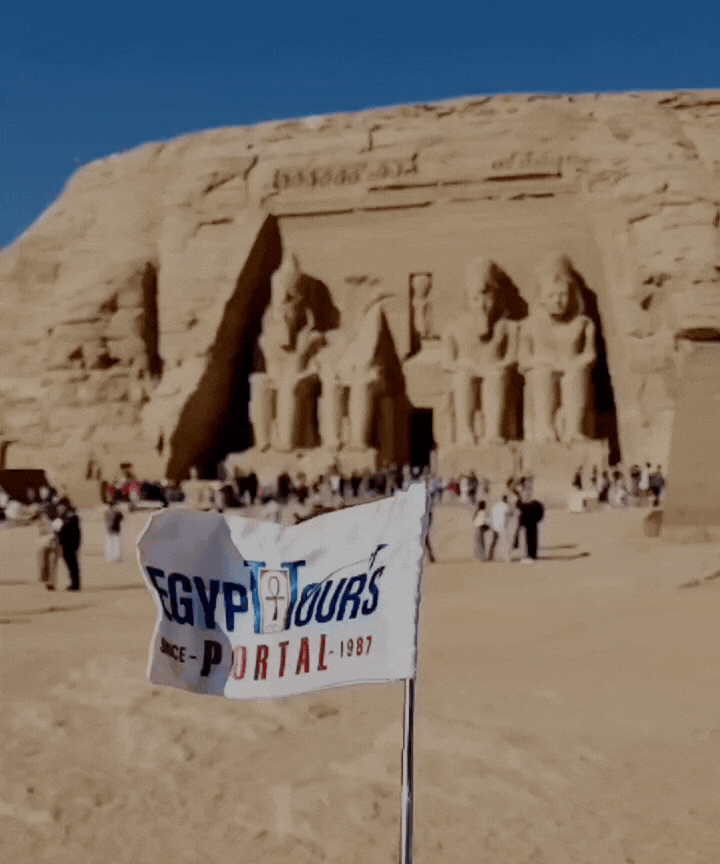
Ancient Egyptian furniture reflects the resourcefulness, artistry, and cultural values of one of history's most influential civilizations. From humble stools to gilded thrones, these pieces symbolized social status and spiritual beliefs. Despite limited native wood, Egyptians innovated through trade and craftsmanship to create functional and symbolic furniture.
Simple designs met daily needs, while ornate pieces adorned temples and tombs, offering insights into ancient aesthetics and rituals. Everyone will get to examine the materials, designs, and significance of Egyptian furniture, highlighting its evolution and enduring influence on art and design.
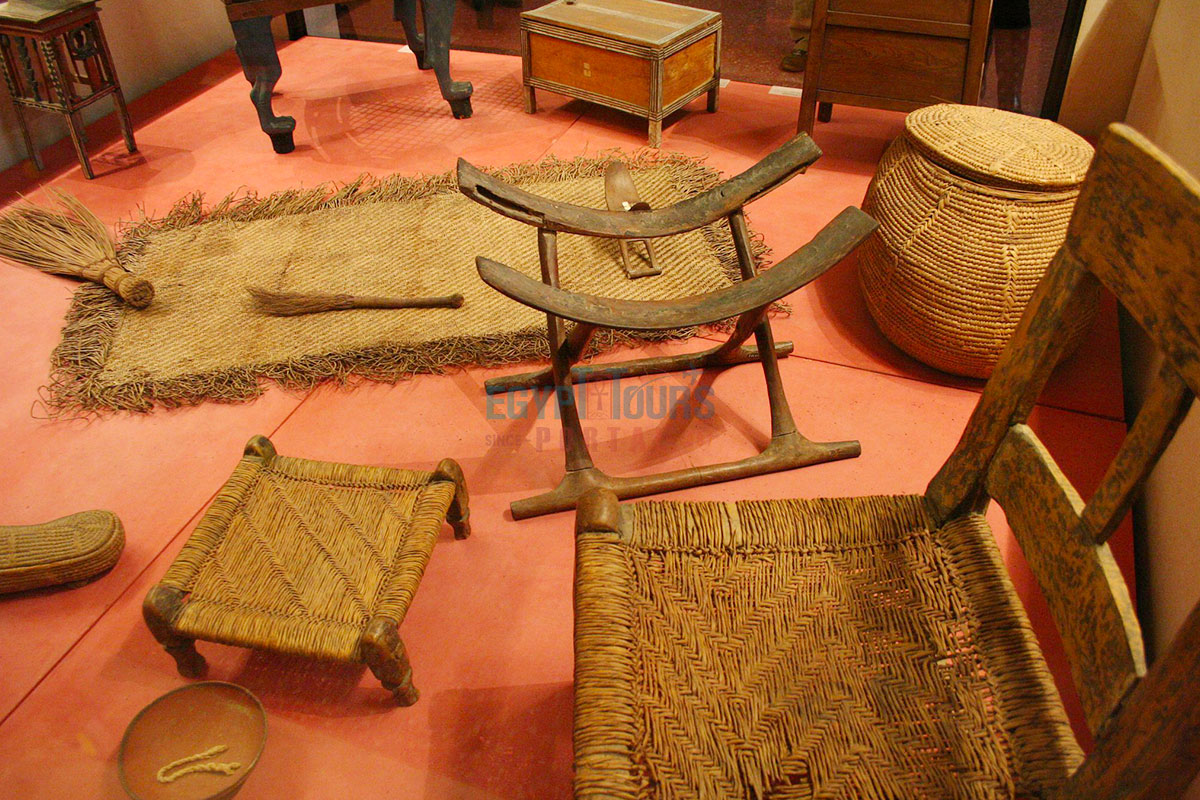
The scarcity of quality native wood in Egypt significantly influenced furniture production. The main local woods—sycamore, acacia, tamarisk, and dom palm—were often of poor quality, knotty, and unsuited for fine craftsmanship. To supplement these materials, Egypt imported luxurious hardwoods like ebony from Kush and Punt and cedar from Lebanon as early as the Old Kingdom (c. 2686–2181 BCE). This trade grew particularly robust during the Middle Kingdom (c. 2055–1650 BCE) and reached its zenith in the New Kingdom (c. 1550–1070 BCE).
Imported materials allowed artisans to incorporate intricate details into furniture, including inlays of ivory, gold, turquoise, and lapis lazuli, which added both aesthetic and symbolic significance. Notable examples of imported wood usage include the cedar coffins of the 4th Dynasty and the intricate gilded chairs found in the tomb of Tutankhamun (c. 1334–1325 BCE).
Woodworkers in Egypt were among the most skilled craftsmen of the ancient world. Using bronze tools—introduced during the Middle Kingdom (c. 2000 BCE)—they perfected techniques such as mortise-and-tenon joints, dovetailing, and pegging, ensuring durability and precision.
Key tools included:
An example of their expertise is the "Anderson Chair" from the Middle Kingdom, which utilized angled joints and inlays of alternating light and dark wood.
Discover intriguing details about the Egyptian craftsmen of this glorious Civilization.
Read More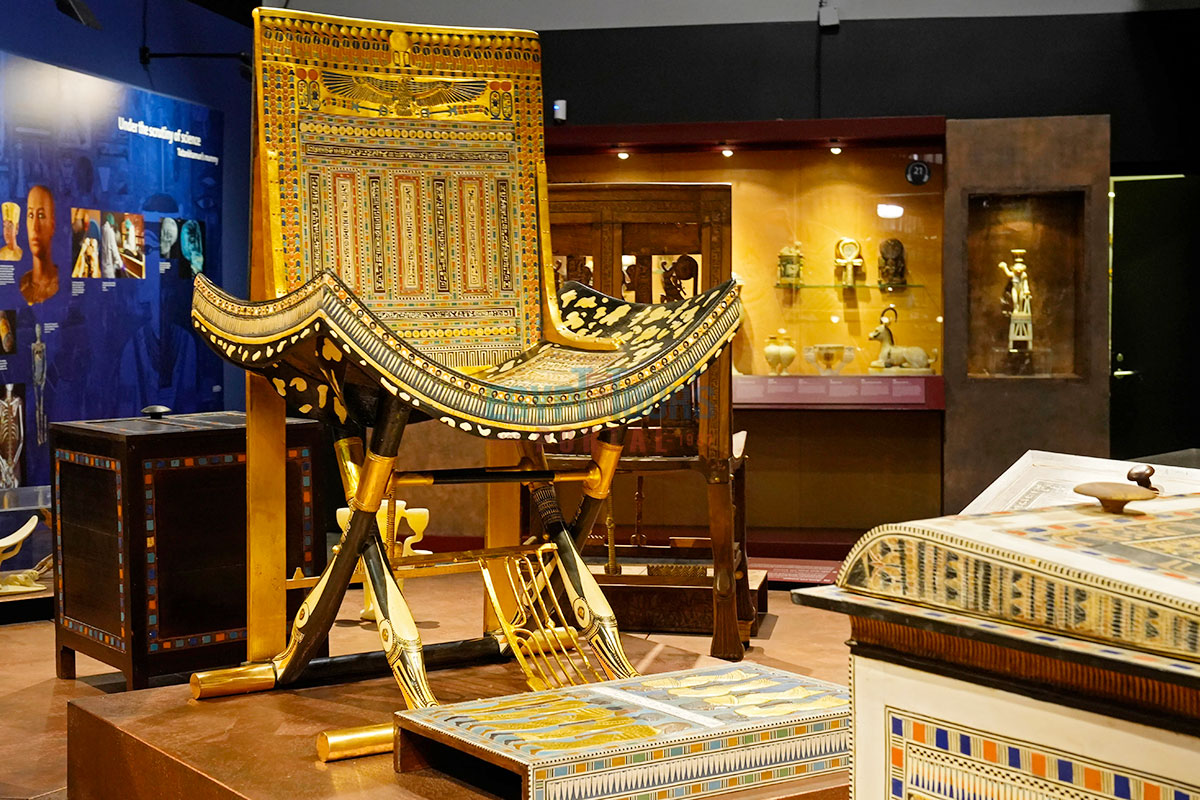
Common Furniture Types in Ancient Egyptian Households include the following:
Ancient Egyptian beds, dating back to the First Dynasty, were constructed from a simple rectangular wooden frame with woven flax or leather cords for support. By the New Kingdom, beds like those of Tutankhamun featured gilded frames and lion-shaped legs, symbolizing royalty.
The most common piece of furniture, stools ranged from basic three-legged designs used by commoners to folding stools with leather seats and duck or goose-shaped legs for the elite. Folding stools appeared as early as the 18th Dynasty (c. 1550 BCE).
Initially exclusive to the elite, chairs emerged during the Second Dynasty (c. 2900 BCE). A stele depicting Prince Nisuheqet shows one of the earliest high-backed chairs. By the 4th Dynasty, chairs with animal-shaped legs became prominent, such as King Khafre's chair adorned with lion motifs.
The earliest tables, used in the Old Kingdom, were simple stone stands. Wooden tables became more common during the New Kingdom, often supported by intricately carved legs or figures of captives symbolizing conquest.
Wooden chests with painted designs were used for storage. The tomb of Queen Hetepheres I (c. 2600 BCE) contained a chest decorated with gold leaf, indicating its royal use.
Daybeds, adorned with cushions and often featuring animal-shaped legs, provided a place for leisure. Crescent-shaped headrests, used since the Old Kingdom, served both practical and ceremonial purposes.
Essential for religious practices, these stands often featured hieroglyphic inscriptions and depictions of gods. They were prominent during the Middle Kingdom and were placed in both temples and homes.
Though rare, these items became more sophisticated during the New Kingdom, reflecting advancements in home organization and literacy.
Explore more fascinating details about the daily routines, beliefs, and traditions of the Egyptians.
Read More
Ancient Egyptian furniture was imbued with rich symbolism, reflecting the culture’s deep connections to nature, religion, and societal values. The choice of motifs, materials, and decorative elements often held spiritual or cultural significance, transforming furniture from functional items into symbols of identity and belief.
Animal designs were central to furniture aesthetics, each chosen for its symbolic attributes:
Furniture often featured religious icons to invoke divine blessings:
The materials used carried their significance:
Examine marvelous facts about the religion of the ancient Egyptians.
Read More
Furniture in Religious and Funerary Contexts was a crucial aspect of burial traditions, designed to ensure comfort and prosperity in the Ancient Egyptian Afterlife. Elaborately crafted and often adorned with inlays of gold, ivory, and semi-precious stones, these items symbolized wealth and spiritual dedication.
Ancient Egyptian Tombs frequently contained beds, chests, and chairs, representing the deceased's earthly life and the belief in its continuation beyond death. Offering tables, central to funerary rituals, were adorned with carvings of food and inscriptions of prayers. These tables facilitated offerings made by family members and priests to honor the dead and secure their well-being in the afterlife.
Ancient Egyptian Religious Symbols, such as the Ankh, representing life, and the Eye of Horus, signifying protection, were often incorporated into the artistic design of these items, underscoring their sacred purpose. Furniture in ancient Egypt mirrored the hierarchical structure of society, with stark contrasts between the pieces used by commoners and the elite.

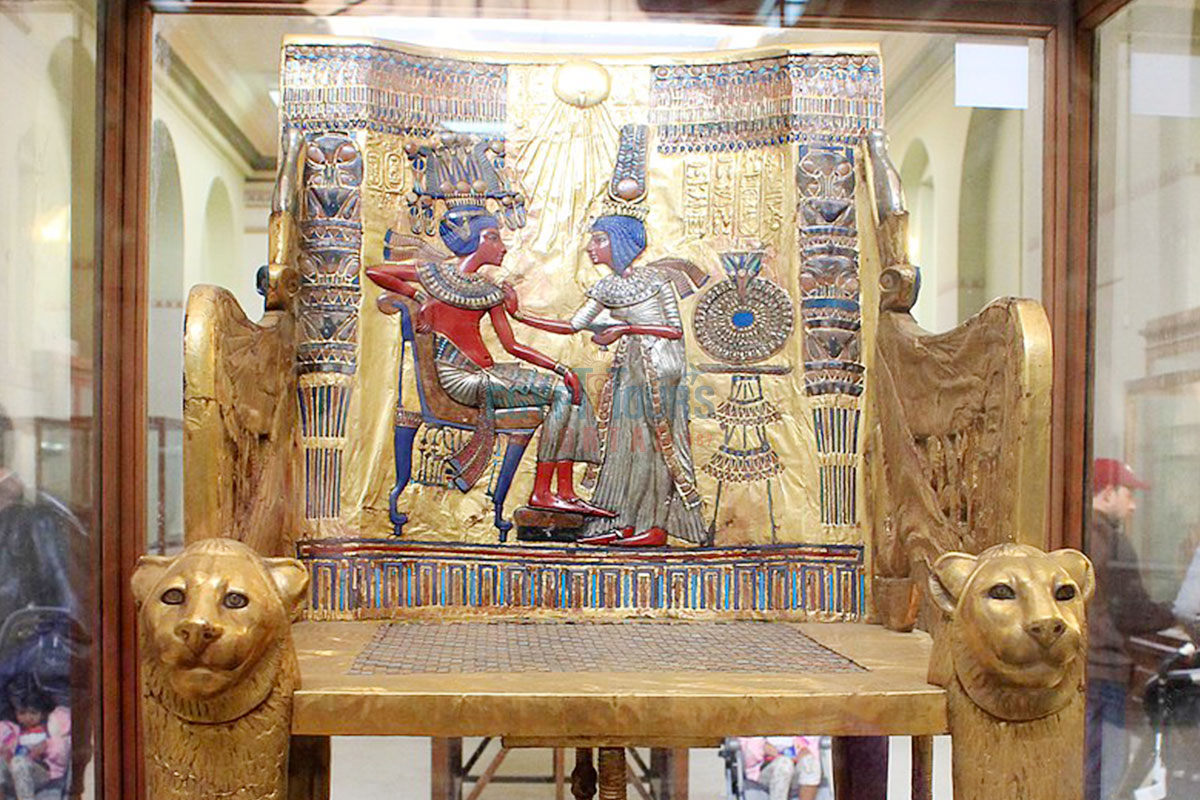
The discovery of Tutankhamun’s tomb (1922) provided an unparalleled view of royal luxury:
Golden Throne: Overlaid with gold sheets, featuring an enamel depiction of the king and queen in an intimate pose, surrounded by symbols of protection and prosperity.
Ceremonial Chairs: Carved with depictions of deities and adorned with animal motifs like lions and hawks to emphasize power.
Decorated Chests: Used for storing jewelry and textiles, these pieces were often painted with scenes of the king’s life and achievements.
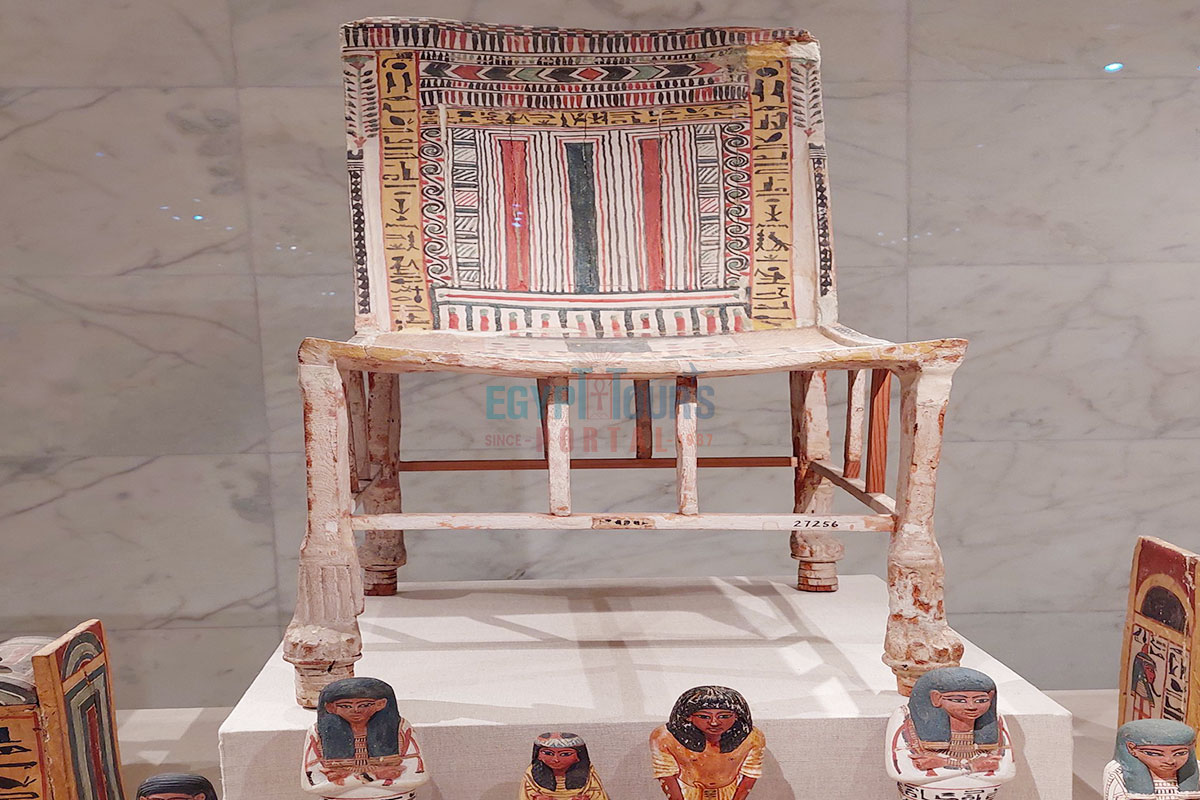

Nubian Influence: Trade with Nubia introduced ebony and ivory, which became staples of luxury furniture.
Levantine Influence: Folding stools with leather seats and boxwood components were adopted during the New Kingdom, reflecting cultural exchange with the Levant.
Greek and Roman Influence: During the Ptolemaic Period (332–30 BCE), curved lines and classical motifs began to appear, blending Egyptian tradition with Greco-Roman aesthetics.

Queen Hetepheres I’s Tomb contained a gilded bed with a canopy, gold-adorned chests, and alabaster vessels, providing insight into the sophistication of 4th Dynasty craftsmanship. Tutankhamun’s Tomb (1922) yielded over 80 pieces of furniture, including thrones, beds, and offering tables, all remarkably preserved and richly decorated.
Egypt’s arid climate aided preservation but also caused challenges due to temperature fluctuations, which could warp wood or cause joints to loosen.
Modern preservation techniques include:
Ancient Egyptian furniture reflects a blend of practicality, artistry, and symbolic depth, showcasing the ingenuity and cultural values of this remarkable civilization. Despite limited native resources, the Egyptians utilized trade and skilled craftsmanship to create furniture ranging from humble stools to gilded thrones, each piece serving both functional and ceremonial purposes.
Their innovative designs and intricate details left a lasting legacy that continues to inspire modern art and design. The innovation and artistic taste of the ancient Egyptians are shown in their unique and magical artifacts, which you can explore with our magnificent Egypt tours from Canada and Nile Cruises.
Private 4 Days Cairo Tour Packages for Canadian Travelers 4 days Cairo Egypt Tour pa...
Tour Location: Cairo – Giza...
5 Days Cairo and Alexandria Tour Package For Canadian Travelers 5 days Cairo and Ale...
Tour Location: Cairo/Giza/Alexandria...
6 Days Cairo, Luxor & Aswan Tour Package For Canadian Travelers 6 days Cairo, Lu...
Tour Location: Cairo/Giza/Aswan/Luxor...
Amazing 7 Days Cairo and Hurghada Holiday for Canadian Travelers 7 Days Cairo & ...
Tour Location: Cairo – Giza – Hurgh...
Ancient Egyptians used wood, reeds, ivory, gold, and imported materials like ebony and cedar for their furniture. Metal and stone were also used for durability and decoration.
Common furniture included beds, stools, chairs, tables, chests, headrests, and benches. Wealthier individuals also had more elaborate and decorated pieces.
Furniture was decorated with carvings, inlays of gold, ivory, and ebony, and painted motifs of religious or symbolic significance, such as animal shapes and geometric patterns.
Furniture reflected social status, religious beliefs, and daily living needs. Tomb furniture symbolized wealth and was intended for use in the afterlife.
Artisans used simple tools like chisels, saws, and drills made of copper or bronze, along with techniques such as mortise-and-tenon joints for durable assembly.
Furniture, including beds, chairs, and chests, was placed in tombs as part of burial rituals to provide for the deceased's comfort and needs in the afterlife.
The wealthy owned elaborate furniture made with imported materials and ornate decorations, while commoners used simpler, functional pieces crafted from local materials like reeds and native woods.
Notable finds include Queen Hetepheres I’s bed and throne, as well as Tutankhamun's golden throne and elaborate chests.
The furniture was practical and lightweight, with foldable stools, portable chests, and multi-functional tables suited to daily needs and limited indoor space.
Yes, altars, offering tables, and ritual chairs were commonly used in temples and households for religious ceremonies and offerings to gods.
Trade with regions like Lebanon and Nubia introduced luxury materials such as cedar and ebony, which were incorporated into Egyptian designs, adding more sophistication.
Royal furniture featured intricate carvings, gold inlays, and luxurious imported woods, while commoners used practical and less ornate furniture made from local materials.
Headrests were believed to support proper posture during sleep and provide spiritual protection, as they were often inscribed with protective symbols.
Wooden furniture is rare due to Egypt’s dry climate, but well-preserved examples have been found in tombs, protected from environmental decay.
They pioneered techniques like mortise-and-tenon joinery, folding stools, and the incorporation of animal motifs in furniture design, influencing furniture styles worldwide.
The entire country of Egypt deserve to be explored with its every heavenly detail but there are places that must be seen before any other such as the breathtaking Hurghada's red sea, The wonders of Cairo the pyramids of Giza, the great sphinx, the Egyptian Museum, Khan El Khalili Bazaar, the wonders of Luxor like Valley of the Kings, Karnak & Hatshepsut temple and the wonders of Aswan such as Abu Simbel temples, Philea temple, Unfinished obelisk and The Wonders of Alexandria like Qaitbat Citadel, Pompey's Pillar and Alexandria Library. Read more about the best places to visit in Egypt.
If you want to apply for a Visa On Arrival that lasts for 30 days then you should be one of the eligible countries, have a valid passport with at least 6 months remaining and pay 25$ USD in cash, as for the E-Visa for 30 day you should have a valid passport for at least 8 months, complete the online application, pay the e-visa fee then print the e-visa to later be presented to the airport border guard. You could also be one of the lucky ones who can obtain a free visa for 90 days. Read more about Egypt travel visa.
Egypt has a variety of delicious cuisines but we recommend “Ful & Ta’meya (Fava Beans and Falafel)”, Mulukhiya, “Koshary”, a traditional Egyptian pasta dish, and Kebab & Kofta, the Egyptian traditional meat dish.
The best time to travel to Egypt is during the winter from September to April as the climate becomes a little tropical accompanied by a magical atmosphere of warm weather with a winter breeze. You will be notified in the week of your trip if the Climate is unsafe and if any changes have been made.
You should pack everything you could ever need in a small bag so you could move easily between your destinations.
We have been creating the finest vacations for more than 20 years around the most majestic destinations in Egypt. Our staff consists of the best operators, guides and drivers who dedicate all of their time & effort to make you have the perfect vacation. All of our tours are customized by Travel, Financial & Time consultants to fit your every possible need during your vacation. It doesn't go without saying that your safety and comfort are our main priority and all of our resources will be directed to provide the finest atmosphere until you return home.
You will feel safe in Egypt as the current atmosphere of the country is quite peaceful after the government took powerful measures like restructuring the entire tourist police to include all the important and tourist attractions in Egypt. Read more about is it safe to travel to Egypt.
Wear whatever feels right and comfortable. It is advised to wear something light and comfortable footwear like a closed-toe shoe to sustain the terrain of Egypt. Put on sun block during your time in Egypt in the summer to protect yourself from the sun.
The best activity is by far boarding a Nile Cruise between Luxor and Aswan or Vise Versa. Witness the beauty of Egypt from a hot balloon or a plane and try all the delicious Egyptian cuisines and drinks plus shopping in old Cairo. Explore the allure and wonders of the red sea in the magical city resorts of Egypt like Hurghada and many more by diving and snorkeling in the marine life or Hurghada. Behold the mesmerizing western desert by a safari trip under the heavenly Egyptian skies.
There are a lot of public holidays in Egypt too many to count either religious or nation, the most important festivals are the holy month of Ramadan which ends with Eid Al Fitr, Christmas and new years eve. Read more about festivals & publich holidays in Egypt.
Egypt is considered to be one of the most liberal Islamic countries but it has become a little bit conservative in the last couple of decades so it is advised to avoid showing your chest, shoulders or legs below the knees.
Arabic is the official language and Most Egyptians, who live in the cities, speak or understand English or at least some English words or phrases. Fewer Egyptians can speak French, Italian, Spanish, and German. Professional tour guides, who work in the tourism sector, are equipped to handle visitors who cannot speak Arabic and they will speak enough English and other languages to fulfill the needs of all our clients.
The fastest way is a car, of course, a taxi. If you are in Cairo ride a white taxi to move faster or you could board the fastest way of transportation in Egypt metro if the roads are in rush hour.
The temperature in Egypt ranges from 37c to 14 c. Summer in Egypt is somehow hot but sometimes it becomes cold at night and winter is cool and mild. The average of low temperatures vary from 9.5 °C in the wintertime to 23 °C in the summertime and the average high temperatures vary from 17 °C in the wintertime to 32 °C in the summertime. The temperature is moderate all along the coasts.
It is the home of everything a traveler might be looking for from amazing historical sites dating to more than 4000 years to enchanting city resorts & beaches. You will live the vacation you deserve as Egypt has everything you could possibly imagine.









